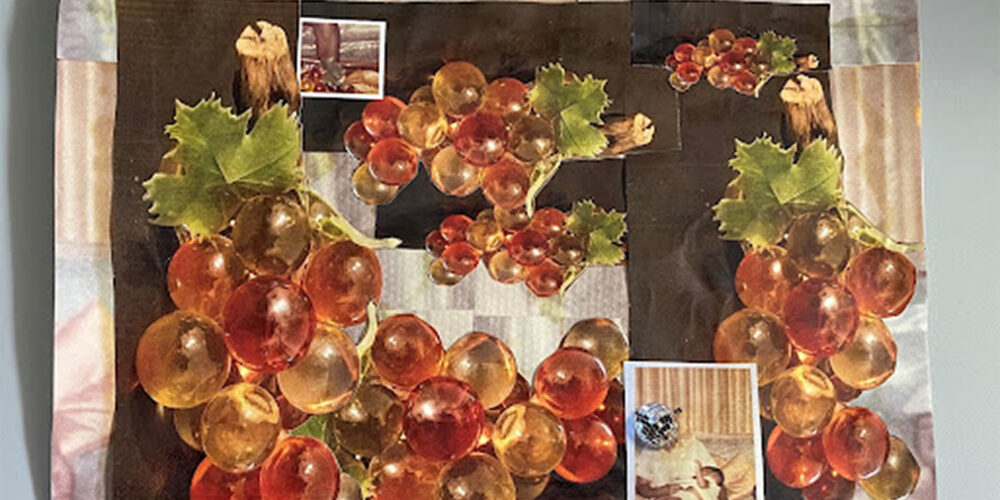By CJ Mitchell, Community Access Manager
Is there an object that conjures up memories from your childhood? For me, it was a piece of decorative art that used to sit on my grandmother’s coffee table. It was a cluster of glass (or resin) grapes, attached to a piece of driftwood at the stem with plastic green leaves. As an infant, my grandmother cared for me while my parents went to work. I have fond memories of feeling safe and cared for by her. So in a sense those grapes are a representation of that time, place, space, and feeling. Farah Al Qasimi’s work Everywhere there is splendor is an installation that reflects her layered relationships with familiar places, spaces, and objects from her past. With this art activity, we will use an object that has significance and sentimentality, to redefine it by creating an abstract collage. In the example I made, I included a picture of my grandmother and me along with a glimpse of those coffee table grapes I remember from my childhood. I covered the face of my grandmother, taking a cue from Farah’s artwork, where images of family members have other images collaged over their faces. Often personal memories are complex and have nuances that can become abstract due to time and distance. This activity invites you to look back into your own memories and create something new from a familiar object.


Ages: Grades 3–12 (8 years–Adult)
Time It Takes: 60–120 minutes (1–2 hours)
What We Are Going To Do:
- Collage
- Photography
- Repetition
- Pattern
You’ll Need:
- Glue
- Paper
- Photocopy or picture of an object that has meaning for you
- Scissors
- Camera
- Computer
Before We Start:
Let’s look at the images and video of Everywhere there is splendor, a work by Farah Al Qasimi on the Project Wall at CAM. This work is a large-scale installation, featuring vinyl wallpaper and four framed photographs hung to it. The installation consists of pictures of items that are unique to the artist that overlay on top of one another. Examples include an image of a woman in a kitchen (Farah’s aunt when she was a young woman) next to a close-up image of a pink fabric and doodle drawings; and a floral arrangement in a vase, with that image repeated in the proximity of a floral sequin applique. These are images the artist has taken from family albums or photographed around the family home that have significance to her. These images are printed and layered in her studio, and then re-photographed so that the over-layering of the images is handled by the artist rather than simply through digital editing. It makes the viewer think about the connections between the objects that are shown, along with the importance of these objects to the artist. I would like to look at one area of Everywhere there is splendor that was the inspiration for this art activity. The third section of the repeated image of the floral vase. How can you use this idea of repetition in your art?



Think About:
- When looking at the work as a whole, how do you think the images relate to one another?
- What do you think is the significance of the objects shown?
- What things do you notice that are repeated in the work?
- Al Qasimi obstructs the identity of people in her work? Why do you think she does this?
Art Activity:
1. Find or take an image of an object that has special meaning for you. Print several copies of that image, and if possible make a variety of different-sized copies. Then cut them out.


2. Next step (if using a personal image): make a copy and print it out. An easy way to do this is to take an image on your phone, then print it. Once printed, use found objects to obscure the faces of the people in the image. Then take a picture of that image and repeat the earlier process of printing that image.

3. For the background, I copied and cut a section of the image to create a pattern that was used for the background. This can be done by making a copy, then selecting a section and repeating that section. Microsoft Word was used to create this pattern.


4. Now these can be cut and arranged on the paper. Glue the sections down.




5. Now arrange your focal object on the paper.


6. Glue the pieces that create your focal point.

7. Add your photographs and it is complete.

